Japan Wood Products
Prices
Dollar Exchange Rates of
27th January 2015
Japan Yen 117.53
Reports From Japan
Postponing additional tax rise boosts consumer
confidence
The results of the December 2014 consumer sentiment
survey were released on 19 January and showed that
consumer confidence improved for the first time in five
months. Consumers are apparently happy to see
postponement of the planned increase in consumption tax.
The overall seasonally adjusted index of sentiment among
households rose to 38.8, but it should be remembered that
readings below 50 signal pessimism.
All of the indices four components rose in December.
Consumer‟s assessment of employment conditions
improved, as did their assessment of income growth
potential. The index on readiness to buy new durable
goods also improved but only to 36.3, still stuck well
within the pessimistic range.
See
http://www.esri.cao.go.jp/en/stat/shouhi/shouhi-e.html

Industrial out rises in December
Data released 30 January from Japan‟s Ministry of
Economy, Trade and Industry (METI) shows that
industrial production rose in December month on month
which is being interpreted as a sign that the economy may
be on track to shed the deflation that has crippled the
country for years.
The numbers from METI show that manufacturing output
increased 0.3% in December year on year and was 1% up
from November. However the consumer price index
(excluding food) was down 0.2% from November.
For more see:
http://www.meti.go.jp/english/statistics/tyo/iip/index.html
At the same time Japan's unemployment rate fell to 3.4%
(down 1% from November) but stagnant wages meant
household spending fell from a year earlier and was 0.3%
down on November, the third consecutive monthly
decline.
With the Japanese economy so dependent on domestic
consumption all eyes are now on the wage negotiations
between businesses and the unions which will set wages
for the next fiscal year. If the unions are successful in their
wage negotiations then domestic consumption could get a
boost.
Housing starts miss target
December housing starts totalled 892,000 according to the
latest figures from the Ministry of Land, Infrastructure,
Transport and Tourism.
This figure represents an almost 15% decline on
December 2013 levels and comes after starts declined in
November. Forecasters expected 2014 housing starts to be
around 900,000. For 2014, housing starts fell 8.9% after
the 11% growth in 2013.
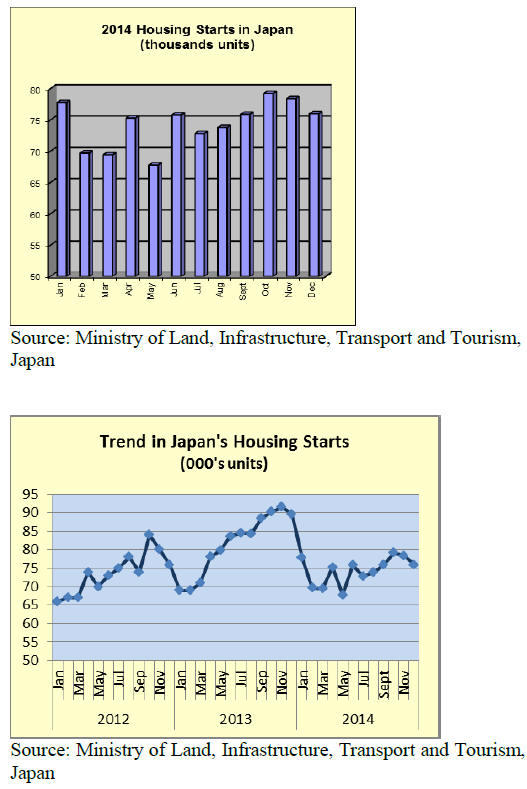
Yen up euro down
Over the past two weeks the yen has strengthened against
the US dollar, driven particularly by the sharp fall in the
euro after the results of the Greek election was announced
and partly because the Bank of Japan (BOJ) did not add
any new initiatives to its stimulus plan that toppled the
yen:dollar rate in October.
The euro fell to an 11-year in the second half of January in
response to the new Greek governments‟ plan to adjust the
austerity measures implemented by the previous
government.
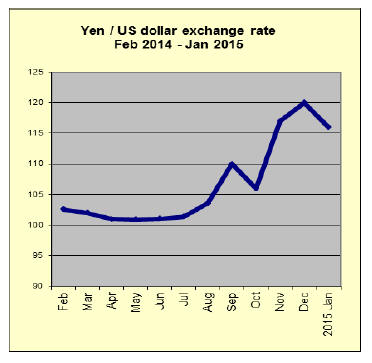
Japan’s furniture imports
Household and office furniture imports by Japan from
2010 to 2014 are shown below. Bedroom and kitchen
furniture imports have held up well over the past 3 years
despite a moribund housing market.
However, some of the apparent increase from 2012 is a
reflection of exchange rates as the yen weakened against
the US dollar, the currency of trade for the major
suppliers.
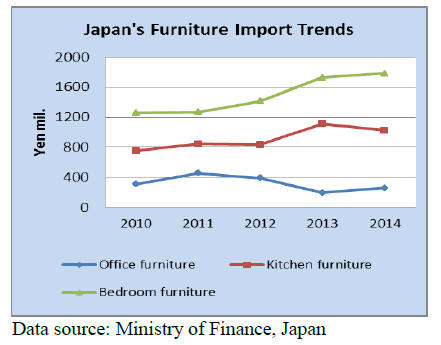
2014 office furniture imports
Cummulative 2014 imports of office furniture by source
are shown below. It can be seen that China dominate
Japan‟s imports of office furniture but manufacturers in
the EU such as Poland Portugal, Italy and Germany
feature in the top five suppliers.
Imports of office furniture from China (48%) and the four
EU suppliers mentioned above account for 80% of all
office furniture imports. Suppliers in tropical countries
(Vietnam, Thailand, Singapore, Malaysia, Philippines and
Indonesia) supplied just 8% of Japan‟s 2014 imports of
office furniture. The top five source countries are
indicated in red.
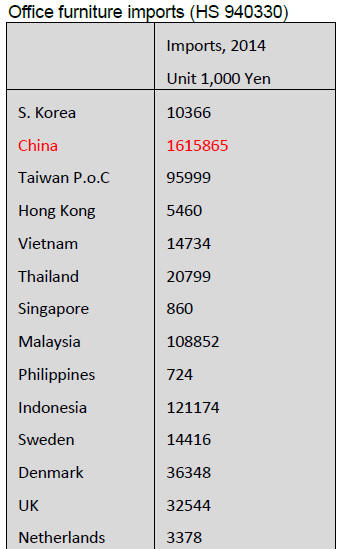 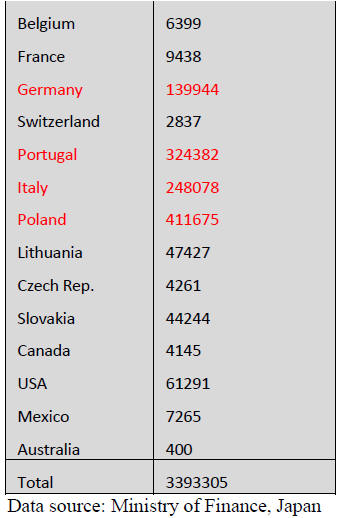

2014 kitchen furniture imports
In contrast to the trade in office furniture, in 2014
suppliers in tropical countries accounted for just over three
quarters (76%) of Japan‟s kitchen furniture imports.
Vietnam was the main supplier of kitchen furniture to
Japan followed by China, Philippines, Indonesia and
Germany. In addition, the list of tropical suppliers
included Thailand and Malaysia. The top five source
countries are indicated in red.
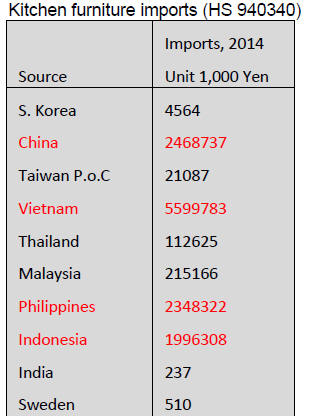 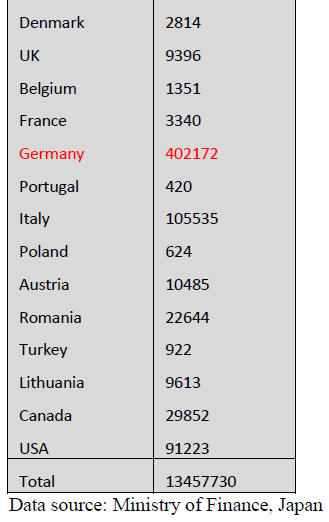
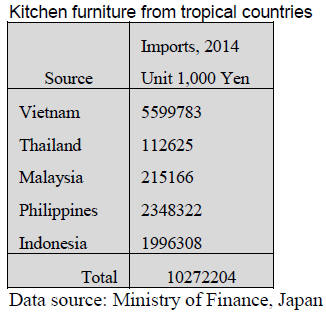
2014 Bedroom furniture imports
Since 2011 the yen value of Japan‟s bedroom furniture has
increased despite the slow housing market and weak
consumer sentiment in terms of buying durable goods.
2014 imports of bedroom furniture by source are shown
below.
The top five suppliers: China, Vietnam, Malaysia,
Thailand and Indonesia (in order of rank) accounted for a
massive 93% of Japan‟s entire imports of bedroom
furniture.
Asian suppliers dominate this trade with Singapore and
Philippines being other major Asian suppliers but not big
enough to make into the top five group. The top five
source countries are indicated in red.
 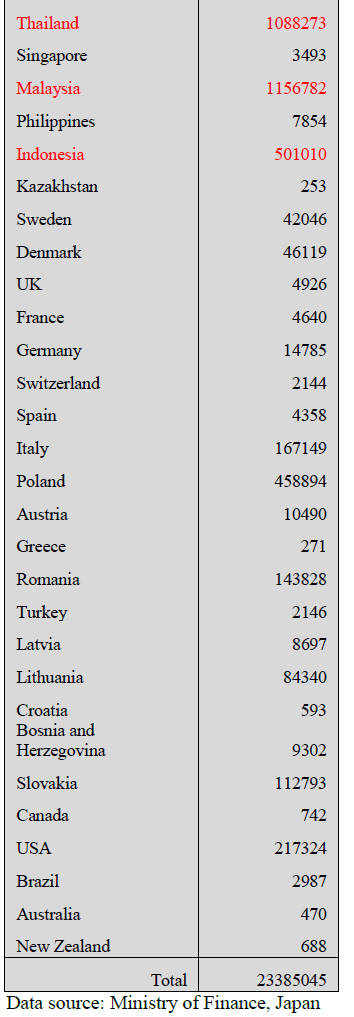
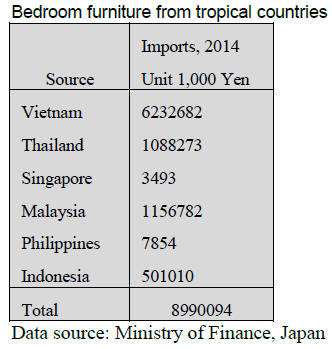
Trade news from the Japan Lumber Reports (JLR)
For the JLR report please see:
http://www.nmokuzai.
com/modules/general/index.php?id=7
Widening gap between costs and market prices for
imported plywood
By progressing depreciation of the yen, future cost of
imported South Sea hardwood plywood is far higher than
the market prices in Japan. Cost of 3x6 concrete forming
panel is 120 yen per sheet higher than October market
prices. The suppliers hold firm stand by high log cost so
future orders continue declining, which will reduce future
arrivals considerably.
Yen‟s rate to the dollar plunged to 120 yen per dollar, 11%
drop compared to late October so even with unchanged
export dollar prices, cost gap jumped up by about 180 yen
per sheet.
Since last May, the demand slowed down after the tax
increase and the future cost has been always far head of
the market prices so that the importers have been reducing
future purchases.
Consequently, monthly arrived volume dropped to
258,890 cbm during August and October from 308,900
cbm during March and July, about 50 M cbms decrease.
Despite three positive factors of high suppliers‟ prices,
weakening yen and dropping inventories, the market
prices remain weak.
Orders to the suppliers in November seem to be down to
60-70% of normal months so the future arrivals will be
considerably reduced. Normal monthly arrivals are over
300 M cbms then they are down to 250 M cbms now and
they may be down close to 200 M cbms in the first quarter.
 
Supply region is in rainy season now and the suppliers are
worried about higher log prices in coming months so
reduction of future orders may be a good news to the
suppliers. Current market prices of JAS 3x6 concrete
forming for coating in Tokyo region are 1,400 yen per
sheet delivered, 40 yen higher than November.
Plywood market developments
Domestic softwood plywood production in October was
219,100 cbms, 4.4% more than September with the
shipment of 221,600 cbms, 1.2% more so the inventories
were 213,000 cbms, which were the almost same as one
month production.
The softwood plywood market started collapsing after
October and the prices have been dropping then the
inventories started shrinking so that the manufacturers
decided to set a new prices since December to restructure
the market, which stopped downward move of the prices.
Dealers had been doing business with very little
inventories but now they have to secure a certain volume
as surplus volume is decreasing.
In Tokyo market, 12 mm 3x6 panel (special grade/F☆☆
☆☆) prices are 860 yen, 40 yen lower than October.
Import plywood market is firming by sudden depreciation
of the yen with declining arrivals. Actually price increase
in Japan market has been way behind the soaring cost so
the importers are worried about if the market prices would
go up to catch up spiraling cost.
October arrivals were 259,500 cbms, 5.2% less than the
same month a year earlier and 10,000 cbms less than
September arrivals. In particular, Malaysian volume was
the lowest this year at 95,100 cbms, 20,000 cbms less than
September.
LVL Association roadmap for development
Japan LVL Association held the regular directors meeting
and the chairman commented that the members have been
struggling to sell LVL after the tax hike in last April
because the demand drop is much more than expected.
The Association has been developing LVL products for
residential use and non-residential use. Since new housing
starts are hard to increase, it is necessary to develop more
non-residential use of LVL.
At the meeting, it showed road map for development of
important factors of materials, structure and fire proof. In
materials, veneer strength simulation will be done for
efficient LVL production like laminated lumber for next
revision of JAS.
For fire proof, fire proof wall, floor and roof will be
developed with performance tests to get the Minister‟s
certificate so that LVL can be used for fire proof
buildings. Also by recent revision of JAS rules, for large
sized beam, producible width, height and length of
laminated lumber, solid wood lumber and LVL are shown
so that designers can select the most suitable material.
Next target is to use LVL for wall like European use since
use of LVL has been mainly for structural post and sill in
Japan.
|